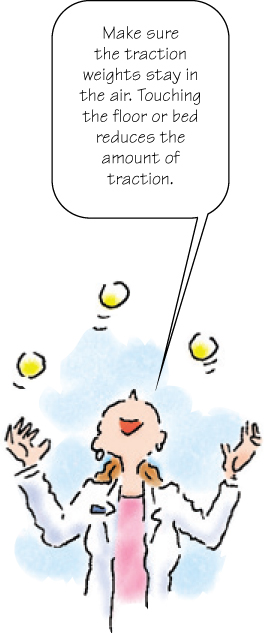Mechanical traction exerts a pulling force on a part of the body—usually the spine, pelvis, or long bones of the arms and legs. It can be used to reduce fractures, treat dislocations, correct or prevent deformities, improve or correct contractures, or decrease muscle spasms. It is not used as frequently as it was in the past because of improved surgical interventions and decreases in length of hospital stays.
Depending on the injury or condition, an orthopedist may order either skin or skeletal traction. Skin traction, applied directly to the skin and thus indirectly to the bone, is ordered when a light, temporary, or noncontinuous pulling force is required and is more commonly used in pediatrics. Contraindications include a severe injury with open wounds, an allergy to tape or other skin traction equipment, circulatory disturbances, dermatitis, and varicose veins.
In skeletal traction, an orthopedist inserts a pin or wire through the bone and attaches the traction equipment to the pin or wire to exert a direct, constant, longitudinal pulling force. Indications include fractures of the tibia, femur, and humerus where surgery is either delayed or contraindicated. Infections, such as osteomyelitis, contraindicate skeletal traction. (See Complications of traction.)
An orthopedic assistant usually is responsible for setting up the traction frame. After the patient is placed in the ordered type of traction, the nurse is responsible for preventing complications from immobility; for routinely inspecting the equipment; for adding traction weights as ordered; and, in patients with skeletal traction, for monitoring pin insertion sites for signs of infection. (See Comparing types of traction.)
Overhead frame: There are three basic frames: the claw-type frame, the intravenous (I.V.)-type frame, and the Balkan frame. All frames consist of bars and clamps to form an overhead frame. The physician will order the type of frame desired, and either the physician or the orthopedic assistant will assemble.
For all frame types: trapeze with clamp  wall bumper or roller.
wall bumper or roller.
For skeletal traction care: sterile cotton-tipped applicators  prescribed antiseptic solution
prescribed antiseptic solution  sterile gauze pads
sterile gauze pads  povidone-iodine solution * optional: antimicrobial ointment.
povidone-iodine solution * optional: antimicrobial ointment.
Arrange with central supply or the appropriate department to have traction equipment transported to the patient's room on a traction cart. If appropriate, gather equipment for pin site care at the patient's bedside. Pin site care protocols may vary with each hospital or physician.
- Explain the purpose of traction to the patient. Emphasize the importance of maintaining proper body alignment after the traction equipment is set up.
Caring for the traction patient
- After traction is set up, show the patient how much movement he's allowed and instruct him not to readjust the equipment. Also tell him to report pain or pressure from the traction equipment.
- At least once per shift, make sure traction equipment connections are tight and that no parts touch the bedding, the patient, or inappropriate portions of the apparatus. Check for impingements such as ropes rubbing on the footboard or getting caught between pulleys. Friction and impingement reduce the effectiveness of traction.
On the ropes
- Inspect traction equipment to ensure correct alignment.
- Inspect ropes for fraying, which eventually can cause a rope to break.
- Make sure ropes are positioned properly in the pulley track. An improperly positioned rope changes the degree of traction.
- To prevent tampering and aid stability and security, make sure all rope ends are taped above the knot.
- Inspect equipment regularly to make sure traction weights hang freely. Weights that touch the floor, bed, or each other reduce the amount of traction.

Check alignment—every 2 hours or 3,000 miles
- About every 2 hours, check the patient for proper body alignment and reposition him as necessary. Misalignment causes ineffective traction and may keep the fracture from healing properly.
- To prevent complications from immobility, assess neurovascular integrity routinely. The patient's condition, hospital routine, and physician's orders determine the frequency of neurovascular assessments.
- Provide skin care, encourage coughing and deep-breathing exercises, and assist with ordered range-of-motion (ROM) exercises for unaffected extremities. Typically, the physician will order a sequential compression device for the unaffected leg(s). Check elimination patterns and provide laxatives as ordered.
- Check the pin site and surrounding skin regularly for signs of infection.
- If ordered, clean the pin site and surrounding skin with a cotton-tipped applicator dipped in the ordered antiseptic. If ordered, apply antimicrobial ointment to the pin sites. Apply a loose sterile dressing or dress with sterile gauze pads soaked in povidone-iodine solution.
- When using skin traction, apply ordered weights slowly and carefully to avoid jerking the affected extremity.
- When applying Buck's traction, make sure the line of pull is always parallel to the bed and not angled downward to prevent pressure on the heel. (See Documenting mechanical traction.)
Outline
